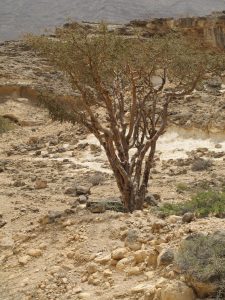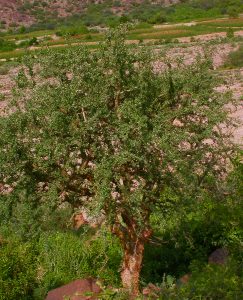Frankincense and myrrh have an almost mystical place in our psyche at this time of year and both can be best be descibed, if unflatteringly, as non-timber forest products.
While frankincense and myrrh are strongly associated with the story of Jesus both have long been revered from Ancient Greece and Egypt, used in the Jewish, Christian and Muslim faiths and were traded eastward in antiquity with India and China for incense and medicinal purposes.
Frankincense is the white resin extracted from species of the genus Boswellia, which grow in arid, cool areas of the Arabian Peninsula, East Africa and India. The resin from Boswellia sacra from Somalia, Oman and Yemen, is considered to be the finest and most aromatic. The resin is also known as olibanum, from the Arabic al-lubān.
Myrrh is a reddish resin that is harvested from species of the genus Commiphora, native to northeast Africa and the adjacent areas of the Arabian Peninsula. Commiphora myrrha, a tree commonly used in the production of myrrh, is found in the shallow, rocky soils of Ethiopia, Kenya, Somalia in Africa and in Oman and Saudi Arabia on the Peninsula. However the myrrh of the Bible is believed to be a related, but different species Commiphora guidottii.
The resins are extracted from both Boswellia and Commiphora trees by making longitudinal cuts in the trunks. The sap slowly exudes from those cut and drips down the tree, forming tear-shaped droplets that are left to harden on the side of the trees before harvesting several weeks later. Mature trees of both Boswellia and Commiphora can yield up to 3kg of resin per year and with frankincense selling for about £40 per kilo and myrrh for about £80 per kg, it makes them valuable regional crops.
While the harvesting is not destructive is does appear to be detrimental in the long term; with a reduction in viable seed production and therefore a reduction in number of young plants to replace the old, see: Limitations to sustainable frankincense production: blocked regeneration, high adult mortality and declining populations. Also the increase in havesting has led to increased pressures on the wider natural envrionment, Rare Arabian leopards forced out by frankincense harvesters.
In Febuary 2017 the Centre for Middle Eastern Plants will be attending an IUCN red-listing workshop in Sharjah where regionally important trees will be assessed or updated.
On that note…..tis the season.



Matthew Heasman
Thanks Alan, very interesting. I do like the frankencense and Myrrh candles🎄